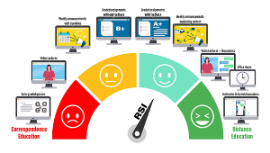Regular and Substantive Interaction (RSI)

RSI Dashboard, by SUNY Empire State College
Click here to view large RSI graphic
History
Stemming from concerns over fraudulent use of Title IV student financial aid, and as a consumer protection mechanism for students, online courses were originally classified as correspondence courses. As such, they were ineligible for Title IV financial aid. In 2005, the Higher Education Reconciliation Act distinguished between distance and correspondence education. The requirement of regular and substantive interaction between instructors and students was established as the differentiating factor between the two types of education. This distinction is important as distance education, unlike correspondence education, is eligible for Title IV financial aid.
Definitions
Even though the requirement of regular and substantive interaction has been articulated, the critical terms were not fully defined until the regulations were released on July 1st, 2021 by the US Department of Education. According to the Distance Education and Innovation Regulations, Chapter 34, §600.2,
Substantive interaction is defined as “engaging students in teaching, learning, and assessment, consistent with the content under discussion, and also includes at least two of the following -
- Providing direct instruction;
- Assessing or providing feedback on a student’s coursework;
- Providing information or responding to questions about the content of a course or competency;
- Facilitating a group discussion regarding the content of a course or competency; or,
- Other instructional activities approved by the institution’s or program’s accrediting agency” (e-CFR, 2021).
Regular interaction is defined as
- “Providing the opportunity for substantive interactions with the student on a predictable and scheduled basis commensurate with the length of time and the amount of content in the course or competency; and
- Monitoring the student’s academic engagement and success and ensuring that an instructor is responsible for promptly and proactively engaging in substantive interaction with the student when needed, on the basis of such monitoring, or upon request by the student” (e-CFR, 2021).
FAQs
What is considered an interaction?
Interaction is understood as one initiated by the instructor. Student-initiated interaction alone will not suffice without instructor-added scheduled opportunities for interaction.
In addition, interaction with artificial intelligence or computer-assisted instructional tools does not meet the requirement for regular and substantive interaction.
Is recorded video considered direct instruction?
A synchronous video lecture is considered direct instruction; however, pre-recorded video alone does not count as direct instruction.
Can virtual office hours fulfill the regular interaction requirements?
Yes.
What is NOT considered regular and substantive interaction?
In the broadest sense, any situation where the instructor interacts with students is considered regular and substantive interaction. Some of the examples of situations that are NOT considered RSI are:
Computer-generated feedback on assessments;
Pre-recorded videos that do not require students to interact with the instructor after watching;
Contact with mentoring staff who are not directly providing instruction on the course’s subject matter;
Online discussion forums not moderated by the instructor;
Student-solicited office hours (regular instructor-set office hours, however, do satisfy the RSI requirement).
Strategies
In your courses, consider including some of the following strategies to promote regular and substantive interaction with your students:
Communication
Virtual office hours - regularly scheduled and announced upfront.
Emails and messages - welcoming students individually to the course and checking on students’ progress in the course. The welcoming message might address course content, what the student can expect in the course, tips for being successful in the course, etc.
Weekly announcements - may contain reminders, course deadlines, notes and summaries of previous week’s activities and learning materials, etc.
Personalized feedback - on activities and assessments.
Syllabus
Regular deadlines posted in the Syllabus (or the Course Schedule) - In addition to clear deadlines, you may also consider implementing partial deadlines in order to initiate interaction.
Statement of the instructor-initiated interaction - lets students know the manner and frequency with which the instructor will initiate the contact. Such statement may be placed in the Syllabus. An example: “I will post weekly announcements summarizing the events of the previous week and posing additional notes about our topic. I will also regularly reach out to see how you are doing in the class.”
Defined response time for student questions and assignment feedback - This information may be placed in the Syllabus. An example of such statement: “I will respond to your emails and messages within 24 hours on weekdays and 48 hours on weekends. I will provide you with feedback on your assignments within four days after the assignment deadline.”
Course Activities
Ask a Question discussion - The purpose of this forum is to offer students space to ask any course-related questions. The discussion may be located at a central and prominent place in the course so that it is easily found from any point in the course.
Community-building discussions - let students get to know one another and their instructor. Examples: icebreaker discussion, ‘How is it going?’ discussion, reflection discussion, etc.
Instructor-facilitated discussion forums - Only discussions with active instructor participation may be considered regular and substantive interaction.
In-course survey - instructor inquiries about the student experience during the course run. The questions might explore the course pace, workload, technical issues, topic relevance to students’ lives, etc. The instructor then analyzes the survey results and adjusts the course design where necessary.
Pre-recorded video lectures with follow-up interactive activities - Pre-recorded videos on their own do not provide students opportunities to interact with the instructor and one another. If, however, videos are a starting point followed by a discussion or a group project with the instructor participation, they fulfill the regular and substantive interaction requirement.
Summary
To summarize, in order to fulfill the RSI requirement, interaction in a distance course should be initiated mostly by the instructor. In addition, the interaction should be predictable and scheduled, with student engagement and success monitoring, and intervention when necessary. Substantive interaction is one that is related to the academic content of the course and contains at least two of the following:
Direct instruction;
Assessing or providing feedback on a student’s coursework;
Providing information or responding to questions about the content of a course;
Facilitating a group discussion regarding the content of a course; or,
Other instructional activities approved by the institution’s or program’s accrediting agency.
Beyond their statement of the amount of interaction being commensurate with the length of time and the amount of content in the course, the Department of Education does not specify timeframe, sequence, or frequency by which interactions need to occur within a course.
Resources
Electronic Code of Federal Regulations [e-CFR] (2021). §600.2 Definitions. https://www.ecfr.gov/cgi-bin/text-idx?SID=e0999d23ca2bd491950f109ebcd507ca&mc=true&node=se34.3.600_12&rgn=div8
Federal Register (September 2, 2020). Rules and Regulations: Department of Education 34 CFR Parts 600, 602, and 668. https://www.govinfo.gov/content/pkg/FR-2020-09-02/pdf/2020-18636.pdf
Kerensky, K. (2021). Regular and substantive interaction refresh: Reviewing & sharing our best interpretation of current guidance and requirements. WCET Frontiers. https://wcetfrontiers.org/2021/08/26/rsi-refresh-sharing-our-best-interpretation-guidance-requirements/
Online Learning Consortium, UPCEA, & WCET (2021). Regular and substantive interaction: Background, concerns, and guiding principles. https://www.insidehighered.com/sites/default/server_files/media/Regular-and-Substantive-Interaction.pdf
SUNY Online Course Quality Review Rubric (2021).
Regular & substantive interaction. https://oscqr.suny.edu/rsi/
How OSCQR supports RSI. https://oscqr.suny.edu/how-oscqr-supports-rsi/
RSI references and resources. https://oscqr.suny.edu/rsi/rsi-references-and-resources/

